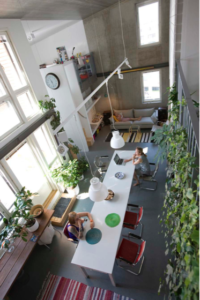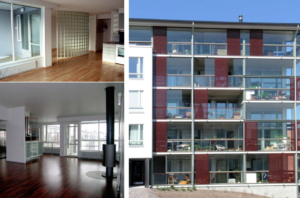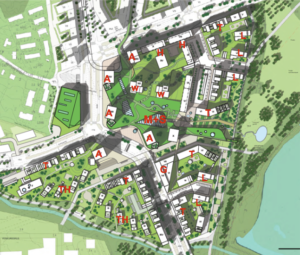Open building examples
See here the thousands of realized homes and other building functions worldwide below with downloads of plans, interviews and technical elaborations on documents, photos and videos.
Open Building is the result of Open Design. Open Building looks at the base building and the fit-out as two separate parts in life; by division of goals, needs and responsibilities; by technology of sustainability and towards (legal, commercial and functional)ownership. In addition, we respect the furniture of the residents and the neighborhood link to the municipality.
The most complete book written about this Residential Open Building by professor emiritus and architect Stephen Kendall and AIA board member and architect Jonathan Teicher contains almost 150 residential projects (including the 50 in the Netherlands!) worldwide, shows the dozens of producers and systems in which and with which Open Building has been realized in way over 1000 homes before 2000.
For decades designers and builders have been realizing projects in residential and commercial building that grant residents and businesses the freedom to have their own fit-out designed and constructed. New and existing residents and businesses repeatedly have the opportunity to adjust their fit-out or even start all over again, all at their own discretion.
A lot has already been written and researched on this subject as seen on more technical or philosophical websites such as http://www.obom.org managed from the Delft University of Technology Architecture Faculty.
Open Design is a method where you, as an individual resident are full partner in the creation of your own home. Your involvement is a necessary condition for the industrialization of housing. In the shop you will find an interesting book about this subject with the total “Open Design”.
Open Design of buildings has many advantages for you. That’s because Open Design takes social sustainability as a starting point which puts you, as a Primary User, up front. In this way social sustainability becomes the foundation for ecological and economic sustainability.
- Open Design is social because during the whole lifecycle your home or workplace can be adjusted to your changing needs or those of new users.
- Open design is ecological because you can apply elements, components, products and materials over and over again.
- Open design is economical because new types of contracts and financing can be applied. The division of property and liability is transparent, simple and unambiguous.
Examples tell more and on these pages illustrate all these aspects.
Invitation
Apart from all this, there are still a dozen countries where Open Design and Open Building projects are realized. Every one of those projects show that meeting the needs of individual residents constitutes a good business case. The shrinking housing market accelerates this process. We now know about residential buildings in Austria, Belgium, China, England, France, Germany, Japan, the Netherlands, Russia, USA and Switzerland.
Of course we want to hear from buildings elsewhere in the world. We would very much like add them to our data so we can offer you an even more complete overview. In addition, we can bring people involved in these projects and other interested parties together. Let’s move on to more opportunities for residents and workers to create their own home!
Examples of Open Building in Netherlands
In the Netherlands a substantial number of Open Design projects has already been realized. The strange thing is that almost nobody knows that they are Open Building creations. Sometimes not even the residents know. That’s because these projects often are the result of the personal ambition of a departing housing association director or a councilor of a municipality? When this particular person retires or accepts a new job elsewhere Open Design disappears from the table; no longer in the interest of the organization or politically contaminated, is the conclusion.
Case Studies NL – adaptable and participatory housing in the Netherlands:
The documentary `CASE STUDIES NL` is a research project that portrays a kaleidoscope of seven Dutch housing developments which all have adaptability and participation of the inhabitants as their core concepts. The key players of each project discuss the failures and successes of the various designs and their underlying processes. Although set in very different contexts and scales, mutual issues arise. Understanding these may help future initiatives and developments to succeed.
#INTRODUCTION
#1 HOMERUSKWARTIER Almere
#2 NIEUW LEYDEN Leiden
#3 SOLIDS Amsterdam
#4 KLUSHUIZEN Rotterdam
#5 MEANDERHOF Zwolle
#6 VRIJBURCHT Amsterdam
#7 GW GEMEENSCHAPPELIJK WONEN Nieuwegein
#EPILOGUE
documentary, 95 minutes, 2014
DVD available at ximage.nl/shop.html
Between 1972 and 1982, the project Lunetten in the city of Utrecht by several housing corporations has been build. In the Netherlands this is the largest – entirely in accordance with the Open Build methods of base building and fit-out separation – completed project with 422 residences. Residents were directly involved in the installation by having an average of two personal interviews with the architect. Then a completely personal installation package for each property is composed and realized by Bruynzeel. In several homes, these Bruynzeel packages still exist, but total replacement after nearly 40 years is imminent. Precisely this replacement can be done today completely without any damage / interference of the base building by the then common method of building section separation. Circular building done well way before anyone being familiar with the concept. More about the actual implementation in the Pocket Book Open Design by the achitect Frans van der Werf.
In 1999, the pilot project Netscher-/Ruijsdaelstraat of VZOS (now HaagWonen) in the city of The Hague was delivered. Residents were not involved with the fit-out. In 2013 the maintenance department states that the involvement of residents is not in the best interests of the housing association. The reason: the large, abnormal and therefore unknown and uncontrollable responsibilities with respect to other traditionally managed association housing.
In 2012, the Amsterdam project Solids from Het Oosten (now Stadgenoot) is completed with a building in (Old) West and a double building in East (IJburg). Despite the extensive publicity surrounding the design and construction, the commissioning and the financial side of the development has been disappointing. Reason: too many new initiatives at the same time, functions that do not reinforce each other (in West) and lack of specific need (in East). Here you can find the powerpoint on the preparation (in Dutch) and the download: The evaluation of Solids (in Dutch).
The open enrollment for West Solid 11 also provided room for a hotel function based on the highest price per m2. The result: half of the building has a shortstay- and hotel function. Only hotel guests have no involvement in the neighborhood. That provides a stark and very disturbing daily contrast with the concerned residents. The building in the East is again filled with traditional social housing. The original target group has little interest for the intended value of the concept of IJburg Solid 1 and 2. After years of delay traditional habitation follows in an now extremely expensive building, including the repay of earlier VAT refunds because the different tax settlements of functions.
At the moment a serie of so-called ‘super loft’ projects in a diversity of cities is on sale or during construction. The are organised by a series of cooperating architects under the name De Hoofden (The Heads in English). See the progress on the website of their projects. An OpenBouwen organization was recently set up by Dutch architects to show the benefits and examples.
A project in Amsterdam currently on sale and to be built in the next year is Schetsblok [in Dutch] with Open Building principles. In de download you find drawings of fit-out options to start with and showing the possibilities. The option of later changes in the building are not mentioned, as is the Japanese principle of renovation later on without disturbing your neighbours. The base building named Casco is offered with the principle of self fit-out. Although the fit-out requested can also be provided by the construction company building the base building. Based on present experience in Japan and former The Netherlands, I would suggest specialised fit-out companies will be able to give a better performance. But so-far those specialised companies have to small a market to flourish.
At the most internationally oriented business center in the Netherlands – the Zuidas – Open Building is seen as a condition to prevent premature demolition of the many high-rise buildings. These so-called Limber Buildings take sustainability as a starting point: the high quality offices must be completely and simply in-fittable, apart from the supporting structure, installations and facade. The municipality sees traditional building as a great risk. Traditional buildings become obsolete fast and often need to be demolished. The local high-rise is on a very densely populated location with crowded public transport and motorway links. It remains to be seen how this will all work out and be controlled. There is a brochure in Dutch and in English.
In the 1980s a flat in Voorburg from the 1950s was completely renovated; the flat was newly fitted with homes based on industrial customization to the individual needs of residents. Most residents have already been living there for more than twenty years, thanks to the fit-out tailored to their personal housing needs. Despite the fact that this fit-out can easyly be customized further, residents have no need for it. They live like buyers but for a rental fee. The housing association has had nothing to worry about for many years already. The supplier of the fit-outs had of course expected more business but did not get it. The success for the residents works to his disadvantage. About this project you will find a presentation here and a descriptive document. Both are in Dutch.
A living/care building in Voorburg was completed in 2013 where the organization of care homes has organized the health care needs of its tenants. The base building is separated from the care taking part and realized by the investor. In this document, the architect and developer expand on that. And here you see their presentation (both in English).
Four buildings were given a personal fit-out in consultation with the residents. Keyenburg in Rotterdam (1984), Molenvliet in Papendrecht (1977), Pelgrimshof in Zevenaar (2000) and Meander in Zwolle (2008). In Rotterdam, the housing association arranged a total renovation with rearrangement of apartment sizes and fit-outs, all in consultation with the existing residents. In Zwolle the residents were also formally client from a Collective Private Commissioning (CPO). Here you will find the project descriptions (in English). In addition, some of these projects are described in detail in the book “Open Design” (in Dutch) in the website shop.
The Ministry of Housing of the Netherlands has led research and delivered various documents. It was doing it mainly to show the benefits of Open Building broad support. A good example is the document around exploring Base Building – Fit-Out agreements rules. Separately, it examined Flexibility in homes to see what changes in the future are required for these homes to meet presently largely unknown requirements and demands of the future of the residents.
Research on financing of Open Building in housesis published by the SAR on financing support incorporation. And DHV report on Base Building – Fit-Out expresses clearly in the 90s the importance of that.
Examples Open Building in Finland
The Finnish examples of buildings and whole neighborhoods show that the benefits increase with a large scale approach. Both in social and ecological sustainability. In one project, the developer mainly applies the modern architecture of the fit-out industrially. In the next project you can see how residents have their two-storey houses fitted with their own traditional wooden fit-out. The many different types of housing in the residential area under construction outside Helsinki really show all Open Building possibilities together. Outside of Japan, this is the most progressive project area with Open Building as the new standard, both with a personal fit-out and with pre-ordered fit-outs from the developer.
In 2015 the following two elderly home buildings with free fit-out for each home these corporations build for their own members. See http://thematicdesign.org/kaivomaki-housing-for-the-elderly and
http://thematicdesign.org/aikalisa-housing-for-seniors-2 With their downloads for details.
You will find several English Downloads here:

a residential building in 2011
Examples Open Building in Japan
Japan made a rigorous decision in 2008 based on extensive research into the limited lifespan of buildings (in Japan then an average of just 30 years), the limited adaptability for the elderly and experience with the costly public funds approach of neighborhoods that ran down socially. Only homes that are adaptable without disturbing the neighbors (left, right, upstairs and downstairs), are still eligible for a subsidy or other public funding. The utilities also must be installed per property in such a way that they are accessible from the (semi) public space and can be customized. These requirements have a lot of (technical) influence on the way of building for all involved. How to solve this challenge is left to the market. Here is a presentation in English with more information about this working method.
Due to the expected large shrinking of the size of Japanese population – from 128 million in 2005 to an expected 90 million in 2055 – large changes in the amount of needed, the quality and the location of homes will occur. See for the latest situation housing update this download in English; “Housing in Japan 2017“. The national housing company Urban Renaissance is preparing the nation for that.
Part of it is the total restructuring from new-build homes to renovation of homes. An example of that approach you can find in the Nogatadanchi project documentation in Tokyo. Part of the houses is put on the market as furnished homes, a corporation of UR with MUJI a large home furnishing company with this booklet showing a lot of available homes as a result. See for more pictures the BRIQS Pinterest Board and the project website.
During the 2015 visit of home development and refurbishment by Remko Zuidema on behalf of the BRIQS foundation the latest changes in policies and implementation have been seen and discussed. A series on blogs shows more of that on briqs.org. One of the new ideas is the way development is brought to market in homes with choices in accessoires as we know it from shipbuilding and car industries. Developer LOOP has this brochure of showing that in this download fold-out (in Japanese).
The large Japanese home builder Haseko – with over half a million homes built – opened their research centre for the fist time to non-Japanse visit. This special situation our founder of BRIQS could have a look behind the scenes. As mostly photographing was not allowed, this Haseko guide book tells you most of the Haseko Research and Development Institute north of Tokyo.
From the year 1993 onward the NEXT21 building in Osaka – made possible by Osaka Gas and inhabited by its employees – has been a showcase of Open Building. Every 7 years the apartment building is completely refurbished with the latest in homes and energy equipment. Each home has a specific family and its own (interior) architect separate from the building architect. In 2015 Remko Zuidema of the BRIQS foundation visited the building to see and hear the latest developments with his own eyes from the founding utility company Osaka Gas. Pictures of the building are published on our NEXT21 Pinterest board.
More on the background at this video:
Find more detailed information on NEXT21 in this big download of all homes for the present fourth fase of development. Also available as a printable A4 booklet to download. Every seven years a new fase starts with new developments being tested in the building. And even in between new plans are executed like seen in this 2014 download of two homes.
As earthquakes occur regularly in Japan and new regulations are developed to protect people in buildings from it, renovations include adapting buildings to new constructions. Discussions between home owners and construction companies occur often nowadays with more claims being inflicted on construction companies due to new regulations and certifications. The national Japanese public-private initiative Center for Housing Renovation and Dispute Settlement (CHORD) receives around a 100 calls a day on conflict discussions. Much information is available by download in the special brochure we received at our visit. Measures and certificates on earthquake risks after renovations form a major part of that.
World Examples of Open Building collected
From the many projects known to us a presentation follows below. In this 90-page download (in English and Chinese and als downloadable from http://open-building.org), professor JIA Beisi from Hong Kong displayed his collected large number of over 46 (!) open building home examples around the world. He especially collected many from Austria and Germany during his ETH Zurich study. On his university page also many articles can be found on recent Open Building in Asia. About his research in the Open Building elsewhere have a look on our developing cities page.
Homes by US turnkey homebuilders are in some case completed as Open Buildings with adaptivity as basis while maintaining high energy efficiency. The company Bensonwood of Boston is one of the frontrunners. The owner presents in this video how Open Builing influenced them and in this video how they totally changed the companies principles, practice and organisation to reach that goal.
In Moscow the top sector of apartment building often makes use of the advantages of Open Building. Only Open Building (Free Plan) is not an official term according to the Moscow Home Inspection. Developers, brokers and architects work according to the principles of Open Building even without the complete latitude. Due to limitations from legislation and regulations not all advantages come into their own. According to the current Russian Construction Law in high-rise buildings spaces with the same function must be situated above and below each other; a living room above and below a living room, a kitchen above and below a kitchen, and so on. In Free Plan Apartments – FPA projects – they do not stick to this. It is not yet certain how such projects will get an official building permit for this exception. Also the loan and financing methods for both developers and buyers need further study. In this English download you will find documents of two buildings in Moscow.
In Flanders, a number of architects of building complexes made by this principle, moreover, premise and experiencing a comeback in research and proposals. See Waldo Galle http://www.scriptiebank.be/scriptie/time-based-design as basis of his PhD research that he finished in 2017.
Healthcare examples of Open Building
From the increasing number of projects known to us a presentation short list below. The US Pentagon co-finances hospitals used by its employees from various divisions of the military. Worldwide the Pentagon demands a separation of base building and fit-out. This separation is a condition for its investment program. The reason for this is that the extensive, ongoing developments in healthcare and health organization are at odds with long-term local investments in buildings. In addition there is a strong correlation between how care is organized and the fit-out, regarded from regulations about climate control and internal lay out. The Pentagon has worldwide investment contracts with more than a 1000 hospitals, all of them are at some day due to fit into these requirements. The Veterans Program of the Pentagon is not yet involved, but may follow later. See the English summary research paper phase 1 (shows first 24 pages, full document available on request) and the powerpoint presentation of the progress made therein.
For almost thirty years the Canton of Bern in Switzerland has been building its real estate for education, healthcare, offices and other public functions according to the division between base building and fit-out. Every single base building must be suitable for all regular utility functions. Meanwhile, several buildings or parts of them, have already changed function which has yielded interesting learning and earn back effects. This English download shows the university Spital Insel hospital plan in Bern and for background documentation and download on the principles. On 12 September 2015 BRIQS foundation was granted a guided visit by the knowledge group of the Canton at the hospital directly after the Open Building World Congress at the ETH in Zurich.
Examples in developing cities
Open Building also has a lot to offer to developing cities in many countries. The economy is growing faster than in already developed countries, which means many homes need to be changed, improved and enlarged quickly. That will be the only way to continue to meet the needs of the existing residents or the residents have to move to more unless neighbourhoods breaking up the social framework and thus avoiding rising areas. Non flexible buildings and neighborhoods are no longer usable and becoming run down soon.
There is an integral method of Open Designs available for affordable housing with additional opportunities for urban agriculture and the generation of solar energy. CSR Netherlands and different international and local aid organizations and governments are considering projects in Brazil, Colombia, Dominican Republic, Indonesia, Kenia, Ethiopia, Ghana, Kenia and South Africa. BRIQS is aiding these developments by supporting investments to social, economical and ecological Open Building developments. Read more about that in this BRIQS principal document on sustanable and affordable homes.
A special Affordable Housing Research Network at the University of Hong Kong that handles this with the support and implementation of JIA Beisi. Because integrity is an integral part of working on homes for developing countries, we agree on the following principles along with our worldwide partners: MASSIVE SMALL DECLARATION
Part of our effort is joined through the Smart City Collective that also is active in Bandung as you van see in this video in English.
You can help us to raise the investments to get going fast!
This post is also available in: Nederlands




